Posts Tagged: Bohart Museum
Entomologist Jeff Smith: The Master Builder of Insect Specimen Drawers
When you slide open the butterfly and moth drawers at the Bohart Museum of Entomology, UC Davis, the color, size and shape of the specimens fascinate you. And then you notice how they are stored--in intricate wooden drawers made by entomologist and...

Jeff Smith, curator of the Lepidoptera collection at the Bohart Museum, stands by the drawers he crafted. (Photo by Kathy Keatley Garvey)

The Bohart Museum drawers are intricately crafted. This one is of pine. Curator Jeff Smith has crafted and donated 2,487 of them for the Bohart Museum of Entomology. (Photo by Kathy Keatley Garvey)

Close-up of a drawer in the Lepidoptera collection, Bohart Museum of Entomology. (Photo by Kathy Keatley Garvey)
Extreme weather accelerates nitrate pollution in groundwater
Extreme weather spurred by climate change, including droughts and heavy rains, may increase the risk of nitrates from fertilizers ending up in groundwater, according to a recent study from researchers at the University of California, Davis. The study found heavy rains after a drought caused nitrates to seep 33 feet under farm fields in as little as 10 days. The study was published in Water Resources Research.
“The conventional wisdom was that it could take several weeks to years for nitrates to move from the crop root zones to reach groundwater,” said corresponding author Isaya Kisekka, a professor in the Departments of Land, Air and Water Resources and Biological and Agricultural Engineering. “We found these extreme events, such as California's atmospheric rivers, are going to move nitrate more quickly.”
In this study, different methods were used to measure how much nitrate, a component of nitrogen fertilizer, was seeping down through the soil in a tomato and cucumber crop near Esparto, California. Scientists conducted their research from 2021 until 2023 when California was experiencing periods of drought followed by atmospheric rivers. They measured nitrate during both the growing seasons and the rainy seasons.
Drought can leave more nitrogen in soil
Previous studies have shown about 40% of nitrogen fertilizer used for vegetables isn't absorbed by the plants but remains in the soil. During droughts, crops don't use nitrogen efficiently, leading to excess nitrogen in the soil. This study found that if a drought is then followed by heavy rainfall, that sudden burst of water causes nitrate to seep in groundwater more quickly. The nitrate concentration in the shallow groundwater exceeded the U.S. Environmental Protection Agency maximum contaminant level of 10 milligrams per liter for drinking water.
“In California, we often say we swing between droughts and floods,” said Kisekka. “These extreme events that come with climate change are going to make the risk of these chemicals ending up in our drinking water much more severe.”
Groundwater is the primary source of drinking water for most of California's Central Valley. In some regions, such as the Tulare Lake Basin, nearly one-third of drinking and irrigation wells exceed the EPA's safe nitrate level. High nitrate levels in drinking water can increase health risks, especially for young children. It may also increase the risk of colorectal cancer.
Need for real-time soil nitrate monitoring
Central Valley farmers are required to report to the Regional Water Board how much nitrogen they applied to their field and how much was removed as part of the crop's yield. The study compared different ways of monitoring when nitrate from fertilizers seep into groundwater. Kisekka said the results highlight the need for affordable, real-time soil nitrate monitoring tools to help farmers manage fertilizer use efficiently.
By using conservation practices that limit leftover nitrates in the crop's root zone after harvest, farmers can help reduce nitrate contamination in groundwater.
This study's data will also help improve a model called SWAT, which is used to track nitrate seepage into groundwater across California's Central Valley. This effort is part of the Central Valley Water Board's program to regulate irrigated farmlands.
Other UC Davis authors include Iael Raij Hoffman, Thomas Harter and Helen Dahlke.
The study was supported by the USDA Natural Resource Conservation Service through its Conservation Effects Assessment Project. The national project is designed to assess the effectiveness of conservation practices across different watersheds. The study also had support from the USDA National Institute of Food and Agriculture.
Pass the Crickets, Please!
"Crickets, anyone? Free sample!" Tabatha Yang, education and outreach coordinator for the Bohart Museum of Entomology, sits at a table at a Bohart open house and points to a line of small paper cups, each containing three...
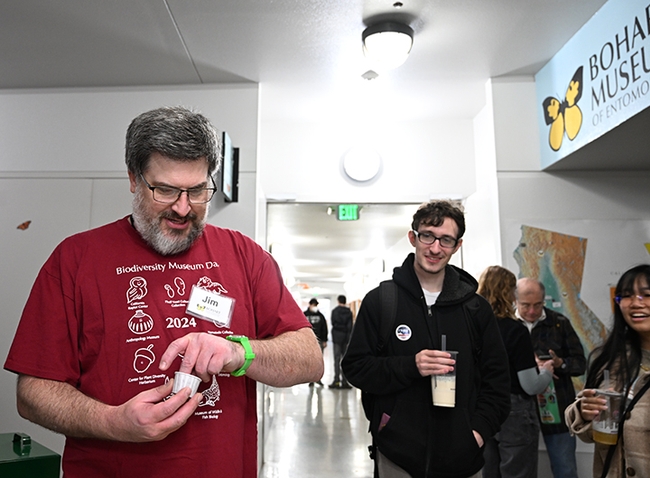
Postdoctoral research scientist James Starrett, of the arachnology lab of Professor Jason Bond, director of the Bohart Museum, gets ready to eat a crickette. (Photo by Kathy Keatley Garvey)
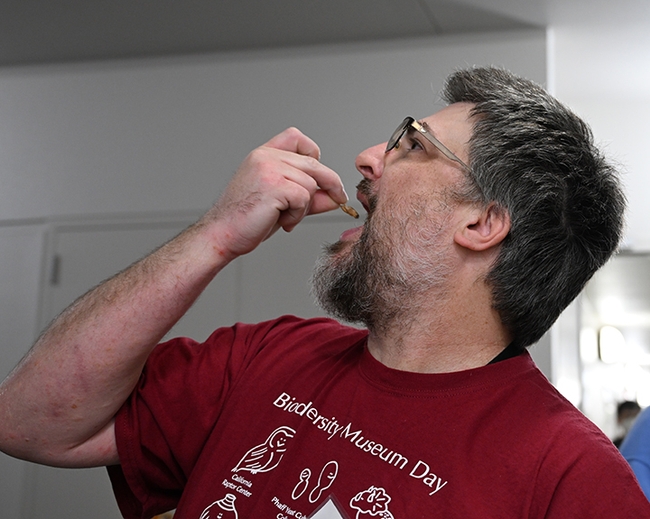
Down the hatch! UC Davis research scientist and arachnoogist James Starrett enjoying a crickette. (Photo by Kathy Keatley Garvey)
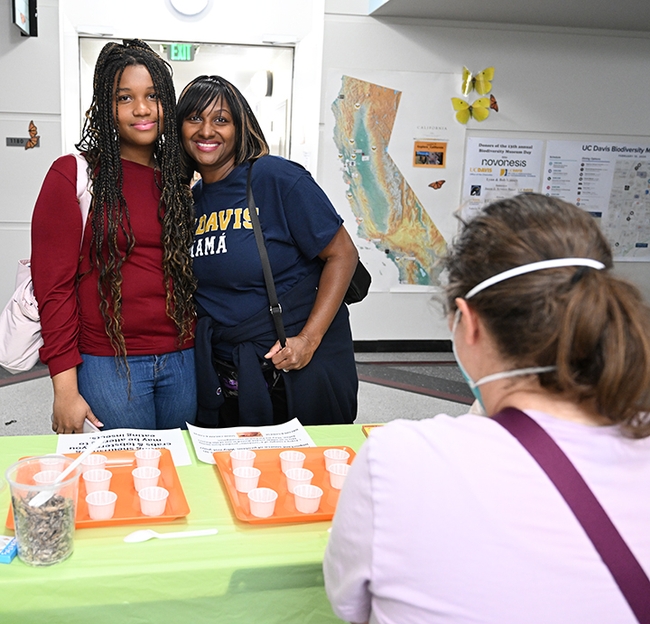
UC Davis student Nia Rhodes, an atmospheric science major, stopped by the cricket booth with her mother, Elizabeth Rhodes of Los Angeles, who is wearing a "UC Davis Mama" shirt. It was Davis Parent and Family Weekend. In the foreground is Tabatha Yang, the Bohart Museum's education and outreach coordinator. (Photo by Kathy Keatley Garvey)
An Introduction to Dragonflies and Spiders
Predators employ a diversity of behavioral and morphological adaptations to successfully capture their insect prey, UC Davis doctoral candidates Christofer Brothers and Emma “Em” Jochim told the crowd at the Bohart Museum of...
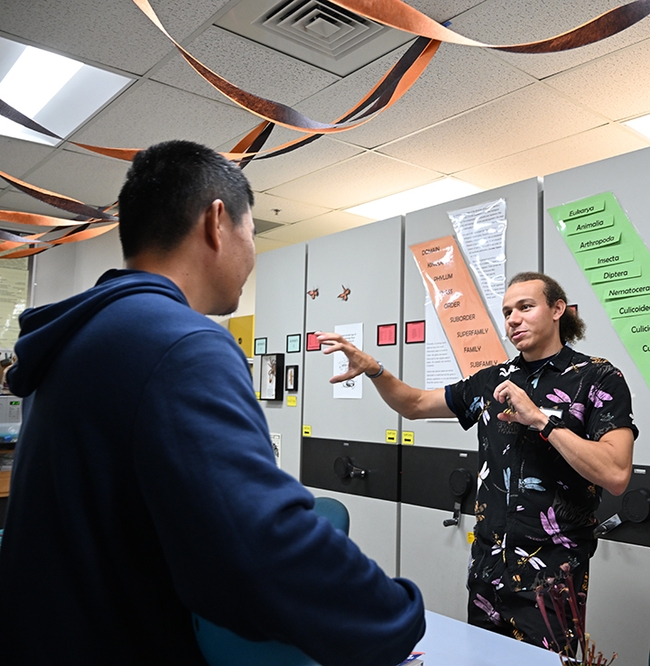
Doctoral candidate Christofer Brothers explains how a dragonfly catches prey. (Photo by Kathy Keatley Garvey)
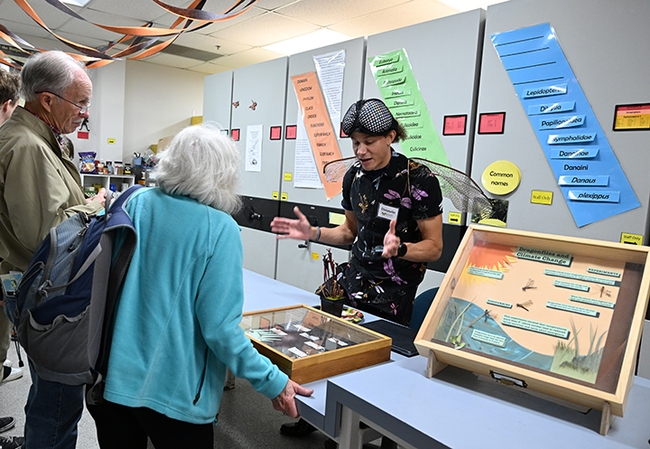
Doctoral candidate Christofer Brothers fielding questions about dragonflies. (Photo by Kathy Keatley Garvey)
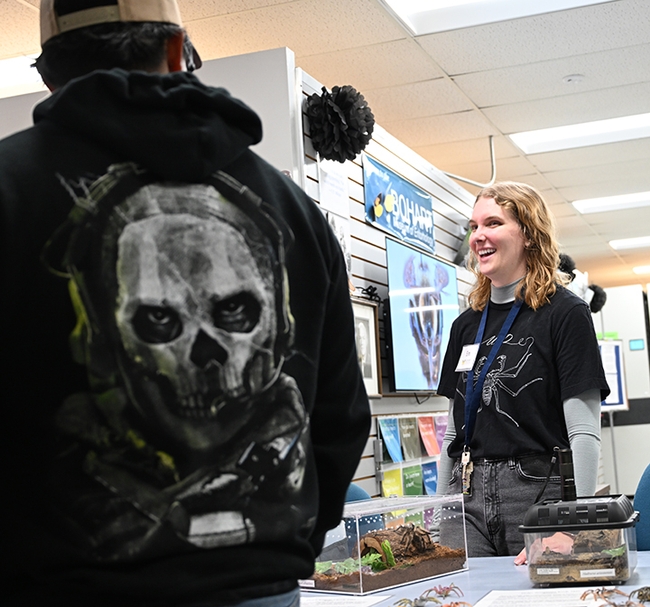
Doctoral candidate Emma "Em" Jochim answers a question about spiders. (Photo by Kathy Keatley Garvey)
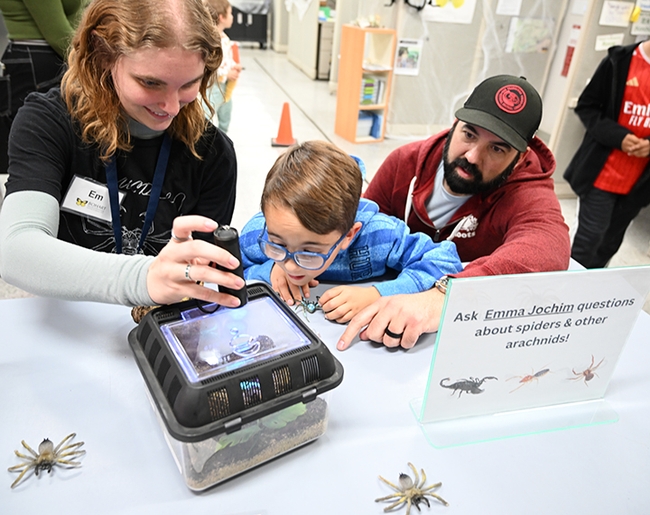
Placerville residents Sullivan Lowe, 6, and his father, Ron Lowe watch as UC Davis doctoral candidate Emma "Em" Jochim fluoresces a tarantula with ultraviolet (UV) light. Sullivan is holding a plastic spider that Jochim gave him. (Photo by Kathy Keatley Garvey)
The Intricate Craft of Making a Spider Web
If you've ever closely examined a spider web, you know how incredible they are. But if you attended the Bohart Museum of Entomology open house last Saturday, you could make a spider web--using chopsticks and colorful yarn. That was the family...

Tabatha Yang (left) the Bohart Museum of Entomology's education and outreach coordinator, with UC Davis student and Bohart intern, Jasmine Chow. (Photo by Kathy Keatley Garvey)

Isaiah Sahakian Frenz, 6, of Davis, listens closely to the instructions on how to make a spider web. (Photo by Kathy Keatley Garvey)

Isaiah Sahakian Frenz, 6, begins working on a spider web. (Photo by Kathy Keatley Garvey)

Isaiah Sahakian Frenz stretches the yarn. (Photo by Kathy Keatley Garvey)

Isaiah Sahakian Frenz and his brother, Levon Sahakian Frenz, mastering the art of making a colorful spider web. (Photo by Kathy Keatley Garvey)

Close-up of the hands of Levon Sahakian Frenz working the yarn. (Photo by Kathy Keatley Garvey)

